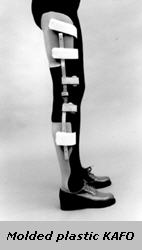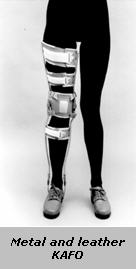.jpg)
 A knee-ankle-foot orthosis (KAFO) extends from the thigh to the foot and may be used to control motion and alignment of the knee and ankle or provide supportfor the femur or tibia or both.
A knee-ankle-foot orthosis (KAFO) extends from the thigh to the foot and may be used to control motion and alignment of the knee and ankle or provide supportfor the femur or tibia or both.
Some KAFO’s are made from metal and leather which consists of two uprights that extend from the ankle up the thigh and include a mechanical knee joint and ankle joints, if appropriate, and are held together by two thigh bands and a thigh cuff. Most designs now use thermoplastics with metal only being used for the uprights and hinges at the knee. The lightweight plastic designs offer more support, are more cosmetically acceptable and can fit into various shoe designs. While the metal braces are more adjustable, they tend to be heavier, bulkier and require special attachments for fitting to shoes. A heavier shoe is also generally required when using the metal brace.
KAFO’s with a knee joint, of which there are many designs, are generally used to keep the knee from bending when there is a loss of or weakness of the quadriceps muscles that straighten the knee.
KAFO’s and knee braces come in various designs and the appropriateness of each design is determined by the type of deformity and functional levels of the individual.
 ASSOCIATED CONDITIONS
ASSOCIATED CONDITIONS
§ Spina Bifida
§ Cerebral Palsy
§ Paraplegia
§ Polio
§ Trauma
§ Muscular Dystrophy
WEARING PROTOCOL
The KAFO is normally used while ambulating. A thorough discussion with your physician and certified orthotist regarding wearing protocol should be undertaken.
DON AND DOFF
While in bed, the brace should be applied by opening the straps and placing the leg so that the foot is positioned in the lower section of the brace . Apply shoe to keep the brace in place. Tighten the brace to tolerance
CARE
§ Plastic Design – Use mild soap and water
§ Metal & Leather Design – Leather can be wiped off, but should not be soaked with water.
§ Molded plastic orthoses should not be subjected to extreme cold without a warm up period. If you are in a cold climate, it is suggested that the patient steps outside to let the plasti ccool before walking. This will aide in any potential breakage of plastic.
SUGGESTIONS
All orthotic designs should have routine maintenance by your certified orthotist. Each three months the first year and each six months thereafter.